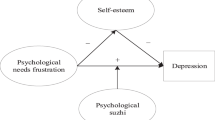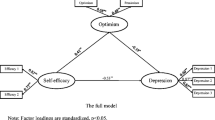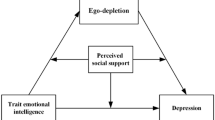Abstract
Positive psychology is the scientific study of positive emotions, positive thoughts and positive behaviors that serve as protective factors to help people bounce back and recover from stress. Fredrickson’s broaden and build model postulates that positive emotions catalyze upward spirals toward future well-being by broadening people’s positive thoughts and behaviors. This study investigated direct and interactional effects of emotional competence and dispositional optimism on depressive symptoms among a sample of secondary school students in Hong Kong, China. A cross sectional survey design was adopted, and data was collected from 513 adolescents (197 males, 316 females, mean age=13.80) from four secondary schools. Results showed that dispositional optimism and emotional competence were significantly and negatively associated with depressive symptoms. In addition, emotional competence enhanced the protective effects of dispositional optimism on depressive symptoms. Therefore, despite their culture-specific meanings in the Chinese context, dispositional optimism and emotional competence were found to independently and jointly protect Chinese adolescents to offset depression, which lends empirical support to the cross-cultural validity of the two positive psychological constructs and the Broaden and Build model of positive emotions. This study sheds light on promoting a positive psychology model that includes both cognitive and emotional positive psychological factors for depression prevention or early intervention.

Similar content being viewed by others
References
Ames, M. E., Rawana, J. S., Gentile, P., & Morgan, A. S. (2013). The protective role of optimism and self-esteem on depressive symptom pathways among Canadian aboriginal youth. Journal of Youth and Adolescence. doi:10.1007/s10964-013-0016-4.
Ashby, F. G., Isen, A. M., & Turken, A. U. (1999). A neuropsychological theory of positive affect and its influence on cognition. Psychological Review, 106, 529–550.
Austin, E. J., Saklofske, D. H., & Egan, V. (2005). Personality, well-being, and health correlates of trait emotional intelligence. Personality and Individual Differences, 38, 547–558.
Bryant, F. B., & Cvengros, J. A. (2004). Distinguishing hope and optimism: two sides of a coin, or two separate coins? Journal of Social and Clinical Psychology, 23, 273–302.
Carbonell, D. M., Reinherz, H. Z., Giaconia, R. M., Stashwick, C. K., Paradis, A. D., & Beardslee, W. R. (2002). Adolescent protective factors promoting resilience in young adults at risk for depression. Child and Adolescent Social Work Journal, 19, 393–412.
Carvajal, S. C. (2012). Global positive expectancies in adolescence and health-related behaviours: longitudinal models of latent growth and cross-lagged effects. Psychology and Health, 27, 916–937.
Carver, C. S., Scheier, M. F., & Segerstrom, S. C. (2010). Optimism. Clinical Psychology Review, 30, 879–889.
Chan, D. W. (2003). Dimensions of emotional intelligence and their relationships with social coping among gifted adolescents in Hong Kong. Journal of Youth and Adolescence, 32, 409–418.
Chan, D. W. (2005). Self-perceived creativity, family hardiness and emotional intelligence of Chinese gifted students in Hong Kong. Journal of Secondary Gifted Education, 16, 47–56.
Chang, E. C., & Sanna, L. J. (2001). Optimism, pessimism, and positive and negative affectivity in middle-aged adults: a test of a cognitive-affective model of psychological adjustment. Psychology and Aging, 16, 524–31.
Chang, E. C., Yu, E. A., & Hirsch, J. K. (2013a). On the confluence of optimism and hope on depressive symptoms in primary care patients: Does doubling up on bonum futurun Proffer any added benefits? The Journal of Positive Psychology, 8(5), 404–411.
Chang, E. C., Elizabeth, A. Y., Kahle, E. R., Jeglic, E. L., & Hirsch, J. K. (2013b). Is doubling up on positive future cognitions associated with lower suicidal risk in latinos?: a look at hope and positive problem orientation. Cognitive Therapy and Research, 37(6), 1285–1293.
Chow, B. W., Chiu, M. M., & Wong, S. W. (2011). Emotional intelligence, social problem-solving skills, and psychological distress: a study of Chinese undergraduate students. Journal of Applied Social Psychology, 41, 1958–1980.
Ciarrochi, J., Deane, F. P., & Anderson, S. (2002). Emotional intelligence moderates the relationship between stress and mental health. Personality and Individual Differences, 32, 197–209.
Dumont, M., & Provost, M. A. (1999). Resilience in adolescents: protective role of social support, coping strategies, self-esteem, and social activities on experience of stress and depression. Journal of Youth and Adolescence, 28, 343–363.
Estrada, C. A., Isen, A. M., & Young, M. J. (1997). Positive affect facilitates integration of information and decreases anchoring in reasoning among physicians. Organizational Behavior and Human Decision Processes, 72, 117–135.
Fredrickson, B. L. (1998). What good are positive emotions? Review of General Psychology, 2, 300–319.
Fredrickson, B. L. (2001). The role of positive emotions in positive psychology: the broaden-and-build theory of positive emotions. American Psychologist, 56, 219–226.
Fredrickson, B. L., & Losada, M. F. (2005). Positive affect and the complex dynamics of human flourishing. American Psychologist, 60, 678–686.
Gillham, J. E., Reivich, K. J., Jaycox, L. H., & Seligman, M. E. P. (1995). Prevention of depressive symptoms in school children: two-year follow-up. Psychological Science, 6, 343–351.
Greenberger, E., Chen, C., Tally, S. R., & Dong, Q. (2000). Family, peer, and individual correlates of depressive symptomatology among US and Chinese adolescents. Journal of Consulting and Clinical Psychology, 68(2), 209.
Hwang, K. K. (2003). Favor and Face: Power Game of Chinese. Taipei: Yuan-Liou.
Kahn, B. E., & Isen, A. M. (1993). The influence of positive affect on variety-seeking among safe, enjoyable products. Journal of Consumer Research, 20, 257–270.
Kang, S., Shaver, P., Sue, S., Min, K., & Jing, H. (2003). Culture specific patterns in the prediction of life satisfaction, roles of emotion, relationship quality and self-esteem. Personality and Social Psychology Bulletin, 29, 1596–1608.
Kitayama, S., Markus, H. R., & Kurokawa, M. (2000). Culture, emotion, and well-being: good feelings in Japan and the United States. Cognition and Emotion, 14, 93–124.
Kwok, S. Y. C. L. (2014a). The moderating role of emotional competence in suicidal ideation among Chinese university students. Journal of Advanced Nursing, 70, 843–854.
Kwok, S. Y. C. L. (2014b). Promoting hope and optimism to decrease anxiety among secondary school students in Hong Kong. Hong Kong: ELCHK (in Chinese).
Kwok, S. Y. C. L., & Shek, D. T. L. (2010). Personal and family correlates of suicidal ideation among Chinese adolescents in Hong Kong. Social Indicators Research, 95, 407–419.
Kwok, S. Y. C. L., Cheng, L., & Wong, D. F. K. (2014). Family emotional support, positive psychological capital and job satisfaction among chinese white-collar workers. Journal of Happiness Studies. doi:10.1007/s10902-014-9522-7.
Lai, J. C. L. (1995). The moderating effect of optimism on the relation between hassles and somatic complaints. Psychological Reports, 76, 883–894.
Lai, J. C. L. (1997). Relative predictive power of the optimism versus the pessimism index of a Chinese version of the Life Orientation Test. Psychological Record, 47, 399–410.
Lai, J. C. (2009). Dispositional optimism buffers the impact of daily hassles on mental health in Chinese adolescents. Personality and Individual Differences, 47, 247–249.
Lai, J. C., & Yue, X. (2000). Measuring optimism in Hong Kong and mainland Chinese with the revised Life Orientation Test. Personality and Individual Differences, 28, 781–796.
Lai, J. C. L., Cheung, H., Lee, W. M., & Yu, H. (1998). The utility of the revised Life Orientation Test to measure optimism among Hong Kong Chinese. International Journal of Psychology, 33, 45–56.
Lee, M. T., Wong, B. P., Chow, B. W. Y., & McBride‐Chang, C. (2006). Predictors of suicide ideation and depression in Hong Kong adolescents: perceptions of academic and family climates. Suicide and Life-Threatening Behavior, 36(1), 82–96.
Leung, C. M., Ho, S., Kan, C. S., Hung, C. H., & Chen, C. N. (1993). Evaluation of the Chinese version of the hospital anxiety and depression scale: a cross-cultural perspective. International Journal of Psychosomatics, 40, 29–34.
Leung, C. M., Wing, Y. K., Kwong, P. K., Lo, A., & Shum, K. (1999). Validation of the Chinese-Cantonese version of the hospital anxiety and depression scale and comparison with the Hamilton rating scale of depression. Acta Psychiatrica Scandinavica, 100, 456–461.
Lewinsohn, P. M., Roberts, R. E., Seeley, J. R., Rohde, P., Gotlib, I. H., & Hops, H. (1994). Adolescent psychopathology: II. Psychosocial risk factors for depression. Journal of Abnormal Psychology, 103, 302.
Lewinsohn, P. M., Rohde, P., & Seeley, J. R. (1998). Major depressive disorder in older adolescents: prevalence, risk factors, and clinical implications. Clinical Psychology Review, 18, 765–794.
Martins, A., Ramalho, N., & Morin, E. (2010). A comprehensive meta-analysis of the relationship between emotional intelligence and health. Personality and Individual Differences, 49, 554–564.
Mavroveli, S., Petrides, K. V., Rieffe, C., & Bakker, F. (2007). Trait emotional intelligence, psychological well-being and peer-rated social competence in adolescence. British Journal of Developmental Psychology, 25, 263–275.
Muris, P., Schmidt, H., Lambrichs, R., & Meesters, C. (2001). Protective and vulnerability factors of depression in normal adolescents. Behaviour Research and Therapy, 39(5), 555–565.
Nelis, D., Quoidbach, J., Mikolajczak, M., & Hansenne, M. (2009). Increasing emotional intelligence: (How) is it possible? Personality and Individual Differences, 47, 36–41.
Nes, L. S., & Segerstrom, S. C. (2006). Dispositional optimism and coping: a meta-analytic review. Personality and Social Psychology Review, 10, 235–251.
Nolen-Hoeksema, S., & Girgus, J. S. (1994). The emergence of gender difference in depression during adolescence. Psychological Bulletin, 115, 424–443.
Pellegrini, A. D., & Blatchford, P. (2000). The Child at School: Interactions with Peers and Teachers. London: Arnold.
Piko, B. F., Kovacs, E., & Fitzpatrick, K. M. (2009). What makes a difference? Understanding the role of protective factors in Hungarian adolescents’ depressive symptomatology. European Child & Adolescent Psychiatry, 18, 617–624.
Puskar, K. R., Sereika, S. M., Lamb, J., Tusaie-Mumford, K., & McGuinness, T. (1999). Optimism and its relationship to depression, coping, anger, and life events in rural adolescents. Issues in Mental Health Nursing, 20, 115–130.
Ridder, D., Schreurs, K., & Bensing, J. (2000). The relative benefits of being optimistic: optimism as a coping resource in multiple sclerosis and Parkinson’s disease. British Journal of Health Psychology, 5, 141–155.
Salovey, P., & Mayer, J. D. (1990). Emotional intelligence. Imagination, Cognition, and Personality, 9, 185–211.
Scheier, M. F., & Carver, C. S. (1985). Optimism, coping, and health: assessment and implications of generalized outcome expectancies. Health Psychology, 4, 219–247.
Schutte, N., Malouff, J., Hall, L., Haggerty, D., Cooper, J., Golden, C., & Dornheim, L. (1998). Development and validation of a measure of emotional intelligence. Personality and Individual Differences, 5, 167–177.
Schutte, N., Malouff, J., Thorsteinsson, E., Bhullar, N., & Rooke, S. (2007). A meta analytic investigation of the relationship between emotional intelligence and health. Personality and Individual Differences, 42, 921–933.
Seligman, M. E. P. (1995). The Optimistic Child. Boston: Houghton Mifflin.
Seligman, M. E., & Csikszentmihalyi, M. (2000). Positive psychology: An introduction. American Psychologist, 55, 5–14.
Shek, D. T. (2004). Chinese cultural beliefs about adversity its relationship to psychological well-being, school adjustment and problem behaviour in Hong Kong adolescents with and without economic disadvantage. Childhood, 11(1), 63–80.
Shek, D. T., & Li, X. (2014). Subjective well-being of early adolescents in Hong Kong. In Chinese Adolescents in Hong Kong (pp. 93–109). Springer Singapore.
Sheldon, K. M., & King, L. (2001). Why positive psychology is necessary. American Psychologist, 56(3), 216.
Shi, J. Y., Shen, J., Xu, Y., & Zhang, J. (2012). The prevalence of depressive symptoms for secondary school students in Suzhou. Chinese Journal of School Health, 32, 1447–1448 (in Chinese).
Siu, A. F. (2009). Trait emotional intelligence and its relationships with problem behavior in Hong Kong adolescents. Personality and Individual Differences, 47, 553–557.
Stewart, S. M., Lewinsohn, P. M., Lee, P. W., Ho, L. M., Kennard, B., Hughes, C. W., & Emslie, G. J. (2002). Symptom patterns in depression and “subthreshold” depression among adolescents in Hong Kong and the United States. Journal of Cross-Cultural Psychology, 33(6), 559–576.
Stewart, S. M., Byrne, B. M., Lee, P. W., Ho, L. M., Kennard, B. D., Hughes, C., & Emslie, G. (2003). Personal versus interpersonal contributions to depressive symptoms among Hong Kong adolescents. International Journal of Psychology, 38(3), 160–169.
Stewart, S. M., Kennard, B. D., Lee, P. W., Hughes, C. W., Mayes, T. L., Emslie, G. J., & Lewinsohn, P. M. (2004). A cross-cultural investigation of cognitions and depressive symptoms in adolescents. Journal of Abnormal Psychology, 113, 248–257.
Tugade, M. M., & Fredrickson, B. L. (2007). Regulation of positive emotions: emotion regulation strategies that promote resilience. Journal of Happiness Studies, 8(3), 311–333.
Twenge, J. M., & Nolen-Hoeksema, S. (2002). Age, gender, race, socioeconomic status, and birth cohort difference on the children’s depression inventory: a meta-analysis. Journal of Abnormal Psychology, 111, 578.
Wong, S. S., & Lim, T. (2009). Hope and optimism in Singaporean adolescents: contributions to depression and life satisfaction. Personality and Individual Differences, 46, 648–652.
Yang, A. L., Fang, X. Y., & Lin, D. H. (2002). The relation between parental conflict, coping strategies and social adjustment for adolescents. Psychological Development and Education, 18, 37–43 (in Chinese).
Yu, Z. P. (2002). Philosophy of time. Southeast Academic Research, 3, 115–123 (in Chinese).
Yu, D. L., & Seligman, M. E. (2002). Preventing depressive symptoms in Chinese children. Prevention and Treatment, 5, 9a.
Yue, X., & Ng, S. H. (1999). Filial obligations and expectations in China: current views from young and old people in Beijing. Asian Journal of Social Psychology, 2, 215–226.
Author information
Authors and Affiliations
Corresponding author
Rights and permissions
About this article
Cite this article
Kwok, S.Y.C.L., Gu, M. The Role of Emotional Competence in the Association Between Optimism and Depression Among Chinese Adolescents. Child Ind Res 10, 171–185 (2017). https://doi.org/10.1007/s12187-016-9366-2
Accepted:
Published:
Issue Date:
DOI: https://doi.org/10.1007/s12187-016-9366-2




